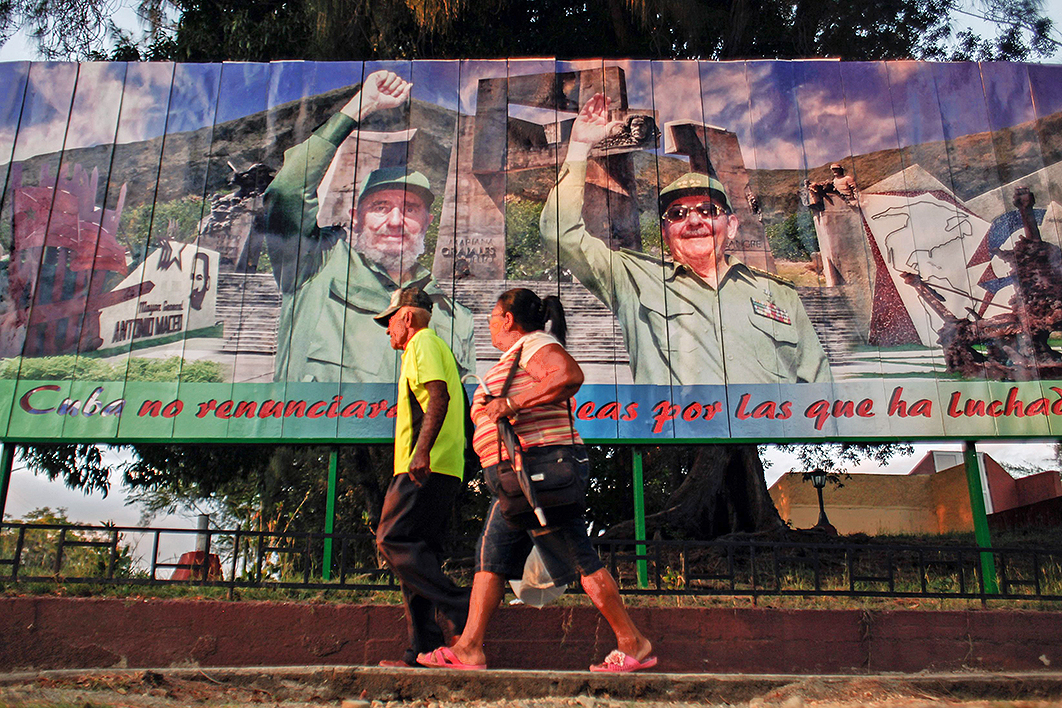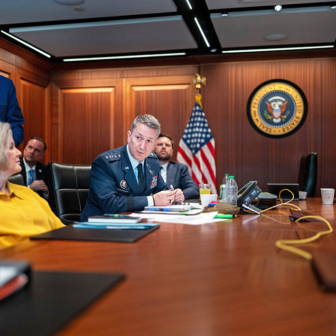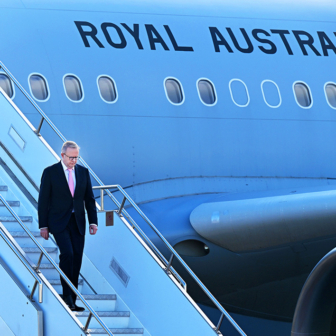I am a truthful man,
From the land of the palms
Before I die, I want to
Share the poems of my soul.
Guantanamera, guajira guantanamera
— “Guantanamera”
Before the music kicks off, Don Angel Macebo Olivares wants to correct what he calls an “international misunderstanding.” The musical director of Guantánamo’s House of Changüí — named after a local nineteenth-century musical style — is anxious to set the record straight. “Guantánamo is not the US naval base,” he tells us, “or that jail they have there.”
Don Angel is welcoming a small audience to an 11am performance by his band. “Guantánamo means a land between rivers,” he says. “It is a land of hard-working people, a land of peace and music.” He turns towards his musicians who, at his nod, break through the sweltering mid-morning heat with “Guantanamera” (a woman from Guantánamo), the legendary Cuban song peppered with verses by José Martí.
Martí is Cuba’s most distinguished poet. He is also a national hero — a key figure in Cuba’s 1895–98 war of independence against Spain, a war closely linked to United States’ takeover of Guantánamo Bay, 120 years ago.
It was in June 1898 that US marines landed at Guantánamo Bay, in the eastern corner of Cuba, under the pretext of aiding the Cuban patriots. The Cubans already had the conflict wrapped up, but the marines landed anyway, raised the US flag and stayed. The occupation received a dubious veneer of legality in 1901 when the US Congress passed the Platt Amendment, a bill ostensibly designed to maintain order in the area.
In February 1903, Washington prevailed on the Cuban government to sign a treaty granting a “perpetual lease” of “lands necessary for coaling or naval stations.” At Guantánamo Bay, nestled between tropical mountains, the Americans built a naval base, a coalmine (later abandoned) and, years later in 2002, a high-security jail.
The town of Guantánamo, meanwhile, had been established in 1796 as a place of exile for thousands of French and Haitian people fleeing Haiti’s 1791–1804 anti-slavery revolutions. Though their home town shares a name with the US base, residents here don’t appear to harbour warm feelings towards the US marines stationed twenty kilometres away.
“Do you mean the yanqui naval base?” Jimena asks me. Among the fifteen high-school students eating a modest meal at the Venus restaurant, a stone’s throw from Martí Square, she is the most outspoken. As we eat our moros y cristianos (Moors and Christians), the ubiquitous Cuban bean-and-rice dish, these teenagers aren’t looking at their mobile phones. Instead, they have things they want to say about the base. “This is a stolen piece of our land,” says Jimena. “It’s like having somebody in the backyard of your house, staying there uninvited, staying illegally.”
Adriel Bosch Cascaret, a young writer and journalist from the town of Guantánamo, has reported widely on the US presence at Guantánamo Bay. “In contrast to many people outside Guantánamo,” he tells me, “we know all about the US naval base — and what happens there — not via the television news but because we feel its proximity.”
The US base, with its 6000 occupants, covers 117.6 square kilometres of Guantánamo Bay, just twenty-three kilometres from the town and its roughly 200,000 residents. It includes the high-security jail that once housed 779 orange-jumpsuit-clad detainees and still houses forty-one of them. “We are so close that on New Year’s Eve we can see the fireworks,” says Bosch Cascaret. He believes that what goes on in the detention centre affects the “psychology” of Guantanameros. “We were very distressed when we learnt of the atrocities committed so close to our town — of the torture and inhuman acts committed there.”
Guantánamo Province, with a mainly Afro-Cuban population of about half a million, is the most eastern province of the island. It is also the poorest. Bosch Cascaret believes that “this place” — the US base — “has been a major deterrence to the development of my town and the province of Guantánamo.”
“The dream of Guantanameros is that one day that enclave will become part of Cuba again,” says José Sánchez Guerra, a Guantánamo-based historian. “It will help to develop the economy of the province and the country.”
Guantánamo Bay is not only the largest and oldest US military base in the world, it is also the only military facility operating within a country with which — until recently — Washington had no direct diplomatic relations. The two countries cut diplomatic ties in 1961, three years after the revolution swept Fidel Castro to power. More than half a century later, under president Barack Obama, Cuba and the United States restored some degree of contact, but they are yet to fully engage diplomatically. In January this year, complicating things further, president Donald Trump signed an executive order keeping open the detention facility at Guantánamo Bay, and paved the way for sending new prisoners there.
Jonathan M. Hansen, a Harvard academic and author of Guantánamo: An American History, describes the US presence as a “thorny issue” for the US–Cuban relationship. “The taking of Guantánamo initiated the United States into an exclusive, if notorious, club of imperialist superpowers,” he tells me, “and established a blueprint for American foreign policy lasting to this day.” The return of Guantánamo Bay has been one of the Cuban government’s key conditions for re-establishing full diplomatic relations between the two countries.
Since the bay is formally “leased” Cuban territory, Washington sends Havana an annual cheque for US$4085 made out to the Treasurer General of the Republic, a position that hasn’t existed since Cuba’s 1959 revolution. The story has it that, apart from a single “mistake” (according to Fidel Castro), none of the cheques has ever been banked. Instead, they were for many years placed in a drawer in the former Cuban leader’s desk. They are now archived in Cuba’s Ministry of Foreign Affairs, leaving there only once, to be displayed in a 2004 exhibition in France.
After the 1959 revolution, Guantánamo Bay attracted a significant number of displeased Cubans who, in their daring search for the elusive American dream, either died or were injured trying to reach the base. In 1961, Fidel Castro ordered the creation of what came to be known as the Cortina de Cactus (the cactus curtain) to deter Cubans from trying to reach the US side of the bay.
Thousands of landmines — Cubans call them quebratas (leg-breakers) — were also laid on both sides. (Neither Cuba nor the United States is a signatory to the 1997 mine ban treaty.) The Clinton administration removed most of the US mines, but Cuba has failed to follow suit. “Officially we don’t hear much discussion about the mined land; but here we all know of its existence,” says Bosch Cascaret.
The closest you can get to the US naval base, assuming you don’t get pricked by a cactus or have your leg blown off, is the fishing town of Caimanera, seventeen kilometres from the town of Guantánamo, and close to the base. A massive billboard on the way into town calls it “the first anti-imperialist trench.”
Caimanera is a tightly guarded military village. The locals have a special entry permit; anyone else has to get authorisation from the interior ministry. Ofelia Garcia Campusano, director of the Caimanera History Museum, tells me that the town’s early development was very much linked to development of the US base. “The base brought an economic bonanza to Caimanera and thousands of people from here found work there.”
The benefits were mainly enjoyed by a small section of town, however. “In fact,” she observes, “the only asphalted and electrified streets in Caimanera are in the zone of prostitution.” The rest of the townspeople were left to languish amid muddy streets, cardboard houses, poverty and neglect.
As a consequence, Caimanera is haemorrhaging residents daily and the average age of its 10,000 residents is rising fast. Few are aged between eighteen and forty. On top of that, it’s a fishing village without fish. “The best catches are in the deep bay water, but we can’t get there, it’s US territory,” says Julio, a fisherman. “One day we will fish there, because one day they will leave.”
Up to 15,000 Cubans worked in the US military enclave in the 1930s and 1940s. That ended when Fidel Castro took power and Havana and Washington ended diplomatic relations. Filipino and Jamaican labourers replaced the Cubans.
“From 1959 the US dismissed thousands of Cuban workers, but a few were allowed to stay,” says Guantánamo historian José Sánchez Guerra. Many Cuban retirees from the US base still live in the town of Guantánamo. Few want to talk about their work at la base, as they called it, because many of them were labelled anti-revolutionaries.
“Don Alfredo” doesn’t mind talking about the old days as long as I don’t mention his real name. When we meet in the cavernous Café Indiana, across from Martí Square, Don Alfredo, an Afro-Cuban, is dressed a colourful guayabera, ironed jeans and polished brown loafers.
“There was once a time when Cubans from Guantánamo, Caimanera and Baracoa used to work in the US navy base,” he says. “I began working there when I was eighteen, I think in 1948.” His father was from the Dominican Republic. “He told me to go work for the gringos because they might take you to the US… There was a bus that would takes us to the US base. It departed from here at dawn.” He tilts his head towards Martí Square. “Like those white-and-red buses you see now in Guantánamo, older versions of them. Some stayed in the base for the whole week, coming back to see their families on the weekend.”
He remembers very well the humiliation Cuban workers endured under the “gringos.” “We were called hutias, you know, the Cuban rat that eats bananas.” He mainly looked after the gardens. “I cut the grass, pruned trees, watered the plants; los gringos have nice green gardens.” When I ask him whether he would have liked to have gone to the United States, he shakes his head furiously. “Never, never. This is my home, Guantánamo is my home.”
Don Alfredo remembers that on their days off the marines would come to town “to have fun, you know, drinking and girls.” But the marines’ trips to the Cuban side came to an abrupt end in 1958 when the current Cuban president, Raúl Castro, then one of the leaders of the Cuban revolutionary movement, kidnapped a bus full of US marines heading to the bars and brothels of Guantánamo. They were released after a few days, but from that point on “not a single US marine has been seen wandering the streets of Guantánamo,” says Don Alfredo.
As the conversation approaches an end and the sun beats down outside, Don Alfredo orders a last coffee. “Los gringos should go home, you know. Guantánamo Bay should be returned to Guantánamo, to us, to this town, Guantánamo is not the naval base.” He looks at me. “Write that down in your book notes.” Many Cubans — but also many Americans — would undoubtedly agree. ●




